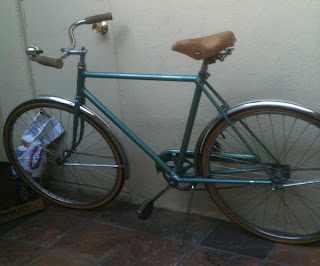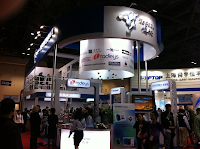 |
| Figure Y: A 1953 Schwinn three speed bicycle. |
Chromatography Quiz #9
 They have won, and will shortly be receiving: Wine Hourglasses courtesy of Uncommongoods.com! Additionally, all participants will be receiving a $20 gift card from Jamba Juice! Again, we would like to thank all of you for your submissions.
They have won, and will shortly be receiving: Wine Hourglasses courtesy of Uncommongoods.com! Additionally, all participants will be receiving a $20 gift card from Jamba Juice! Again, we would like to thank all of you for your submissions. |
TIME
|
Li275 %
|
Li750 %
|
RG003 %
|
|
0
|
100
|
0
|
0
|
|
12
|
100
|
0
|
0
|
|
48
|
65
|
35
|
0
|
|
90
|
0
|
100
|
0
|
|
95
|
0
|
100
|
0
|
|
120
|
0
|
94
|
6
|
|
122
|
0
|
94
|
6
|
|
122.1
|
100
|
0
|
0
|
|
140
|
100
|
0
|
0
|
Pickering Products
Mycotoxins: Clean-up Columns, ELISA Kits, Post-Column Derivatization Instruments & Methods, SPE manifolds (manual & automated) for the analysis of:
Aflatoxins
Ochratoxin A
DON
Nivalenol
Fumonisin FB1, FB2
Zearalenone
Ergot Alkaloids
Post-Column Derivatization: Pinnacle PCX, Vector PCX, UVE Photochemical Reactor, Columns, Reagents, Eluants for the analysis of:
Antioxidants
Mycotoxins (individual and multi-residue)
Amino Acids
Biogenic Amines
Paralytic Shellfish Toxin
Polyether Antibiotics
Hexavalent Chromium
Vitamins
Sugars
Nitrate/Nitrite
Bromate
Carbamate Pesticides
Glyphosate Herbicide
NDELA
Formaldehyde
Sample Preparation (clean-up) Instruments:
FREESTYLE for SPE, GPC, online-concentration
FREESTYLE ThermELUTE for Aflatoxin analysis (direct inject onto HPLC)
AcceCLEAN for SPE (incl. Immunoaffinity columns)
EluVAC vacuum manifold for SPE (incl. Immunoaffinity columns)
GPC QUATTRO for manual GPC Cleanup
DECS System for the cleanup of samples for Dioxin analysis
Chemistry Products:
Artificial Perspiration
Artificial Saliva
High Purity Water
For any applications requiring an inert flow path, volumes up to 70mL, and pressures up to 500psi
For More Information visit:
www.pickeringlabs.com
or email: sales@pickeringlabs.com
Antioxidants Are No Accident
| Photo from FoodProductDesign.com |
Researches optimized HPLC conditions as well as post-column parameters such as concentration of post-column reagent, duration of derivatization reaction and reaction temperature. Trolox and 20 other phenolic compounds were investigated and scientists were able to demonstrate good correlation between Trolox equivalent antioxidant capacity (TEAC) determined by HPLC with post-column derivatization and standard colorimetic assay. This method was successfully applied to analysis of extracts from sloe fruits and mirabelle plums and allowed to calculate concentration of individual antioxidants as well as TE antioxidant capacity.
New! FREESTYLE Series Instrumentation
The Freestyle™ begins with:
- FREESTYLE™ Basic, which has an XYZ robotic arm for automated liquid handling; dilutions, additions, mixing, extraction, dispensing, and other operations.
- Add the GPC module for GPC processing of up to 4 GPC columns.
- Add to this the SPE module to enable SPE processing.
- Add the EVA module for programmable evaporation and solvent exchange for a completely automated in-line evaporation instrument.
The
FREESTYLE™software is drag and drop to program multiple sample parameters and able to handle exceptions to insert into the workflow. Graphical reporting and full audit logs round out the robust software.The FREESTYLE™ automation of sample clean-up saves time, improves consistency and protects your staff from potentially harmful chemical exposure.
Send us an email or give us a call to find out how FREESTYLE™ can solve your sample clean-up challenges.
Email: sales@pickeringlabs.com
Phone: Toll-free: 800-654-3330, Direct: 650-694-6700
Pickering Participates in BCEIA 2011 in Beijing, China
 |
| Beijing, outside of Exhibition Center |
 The Beijing Conference and Exhibition on Instrumental Analysis was held on October 12-15, 2011 at the Beijing Exhibition Center. This biennial exhibition is sponsored by the China Association for Instrumental Analysis and supported by the Ministry of Science and Technology of China. The BCEIA is 3 days long, because it will take you a full three days to cover all 17,000m² of exhibition space.
The Beijing Conference and Exhibition on Instrumental Analysis was held on October 12-15, 2011 at the Beijing Exhibition Center. This biennial exhibition is sponsored by the China Association for Instrumental Analysis and supported by the Ministry of Science and Technology of China. The BCEIA is 3 days long, because it will take you a full three days to cover all 17,000m² of exhibition space.
The Beijing Exhibition Center became a bustling city of exhibitors and guests from all over the world showcasing instruments from the fields of Electron Microscopy & Material Sciences, Mass Spectrometry, Optical Spectroscopy, Chromatography, Magnetic Resonance, Electroanalytical Chemistry, Analytical Techniques in Life Science and Environmental Analysis.
 |
| BCEIA Exhibition Hall |
 |
| David and Ameritech in Tianjin City |
 |
| David and Tegent |
Both distributors have been working with Pickering Laboratories for many years and are completely capable of supporting our post-column instruments and applications. Their hospitality was incredible and I look forward to visiting them again in the near future.
Chromatography Quiz
Chromatography Quiz #7 Results
 We would like to congratulate the grand prize winner of our last newsletter’s Amino Acid Analysis Chromatography Quiz: Jaime Lee Palmer from Underwriters Laboratories!!!
We would like to congratulate the grand prize winner of our last newsletter’s Amino Acid Analysis Chromatography Quiz: Jaime Lee Palmer from Underwriters Laboratories!!!
She has won, and will shortly be receiving: a gift card for Barnes and Noble! Additionally, for this quiz all our participants will each be receiving a Smiley Face Sampler Box courtesy of The Popcorn Factory! Again, we would like to thank all of you for your submissions.
The correct answer for the modified Amino Acids chromatogram: the Trione reagent is oxidized. Either the reagent has been improperly stored (not under Nitrogen), or has been in extended contact with air.
Thank you!
Pickering Labs
Chromatography Quiz #8:
Identify the error made when running the Carbamates chromatogram below and win a prize! Simply email your answer as well as your full contact information to Rebecca at rlsmith@pickeringlabs.com by January 31st in order to win. You will receive email confirmation that your submission has been received. The troubleshooting answer and winner congratulations will be published in the next issue (to be anonymous, please notify Rebecca in submission).
Carbamate Analysis for US EPA Method 531.1
Pickering Column: 1846250 Carbamate Column, C18, 4.6 x 250 mm
Sample: Actual customer’s 531.1 standard at 10ppb
Normal Operating Conditions: (for reference only, condition changes may be reflected in chromatogram)
Column Temperature: 42 °C
Flow rate: 1 mL/min
Eluant Gradient:
|
TIME
|
WATER
|
MeOH %
|
|
0
|
85
|
15
|
|
1
|
85
|
15
|
|
44
|
25
|
75
|
|
44.1
|
0
|
100
|
|
49
|
0
|
100
|
|
49.1
|
85
|
15
|
|
57
|
85
|
15
|
Post-column conditions:
Reagent 1: Hydrolysis reagent CB130
Reagent 2: 100 mg of OPA, 2 g Thiofluor™ in 950 mL of CB910
Reactor 1: 100 °C, 0.5 mL
Reactor 2: ambient. 0.1 mL
Reagent flow rates: 0.3 mL/min
Detection: Fluorometer ex 330 nm, em 465 nm
Full Chromatogram:
Enlarged View:
Further Enlarged View:
For an example of a Good Carbamate Chromatogram, click here








